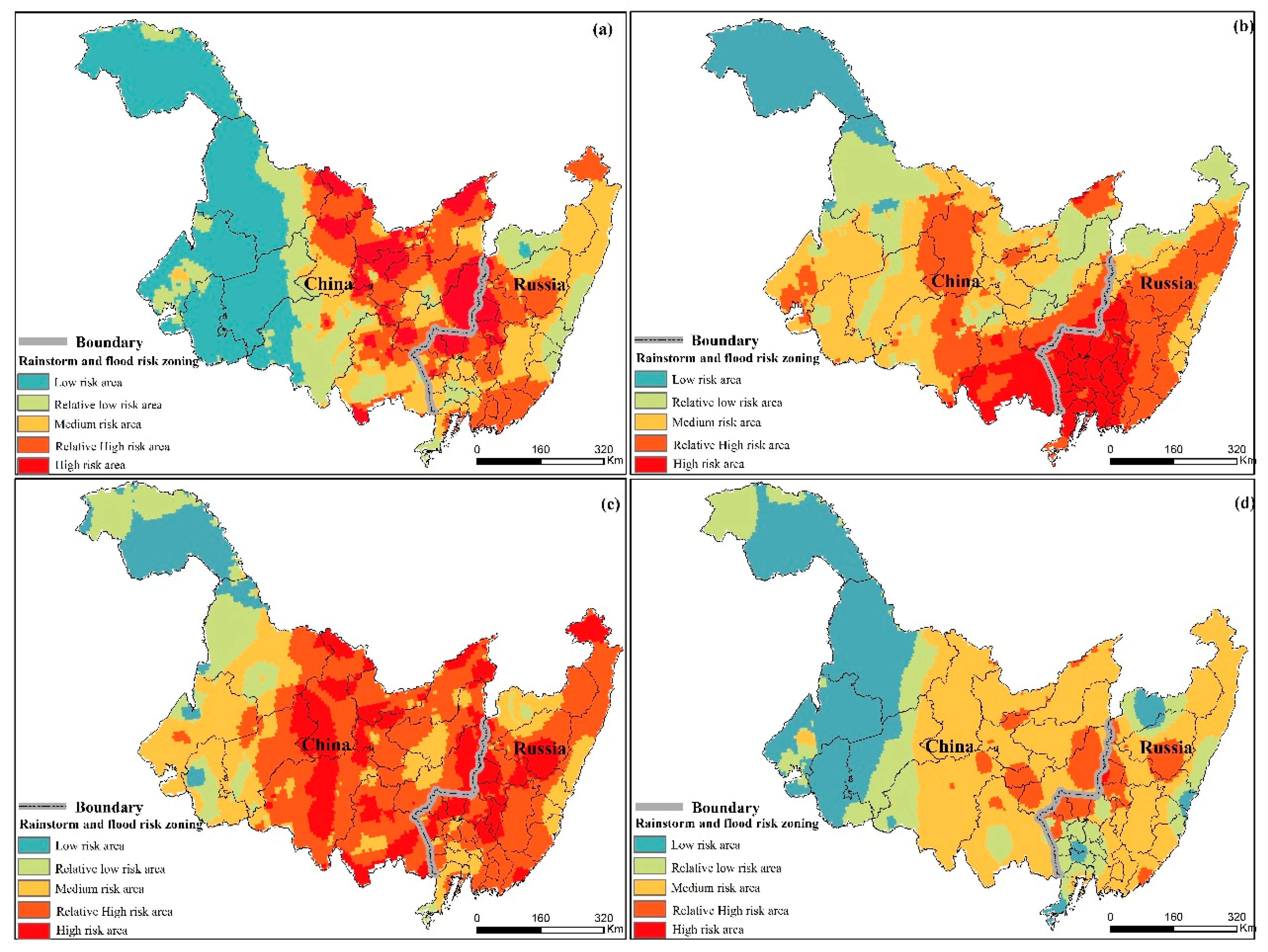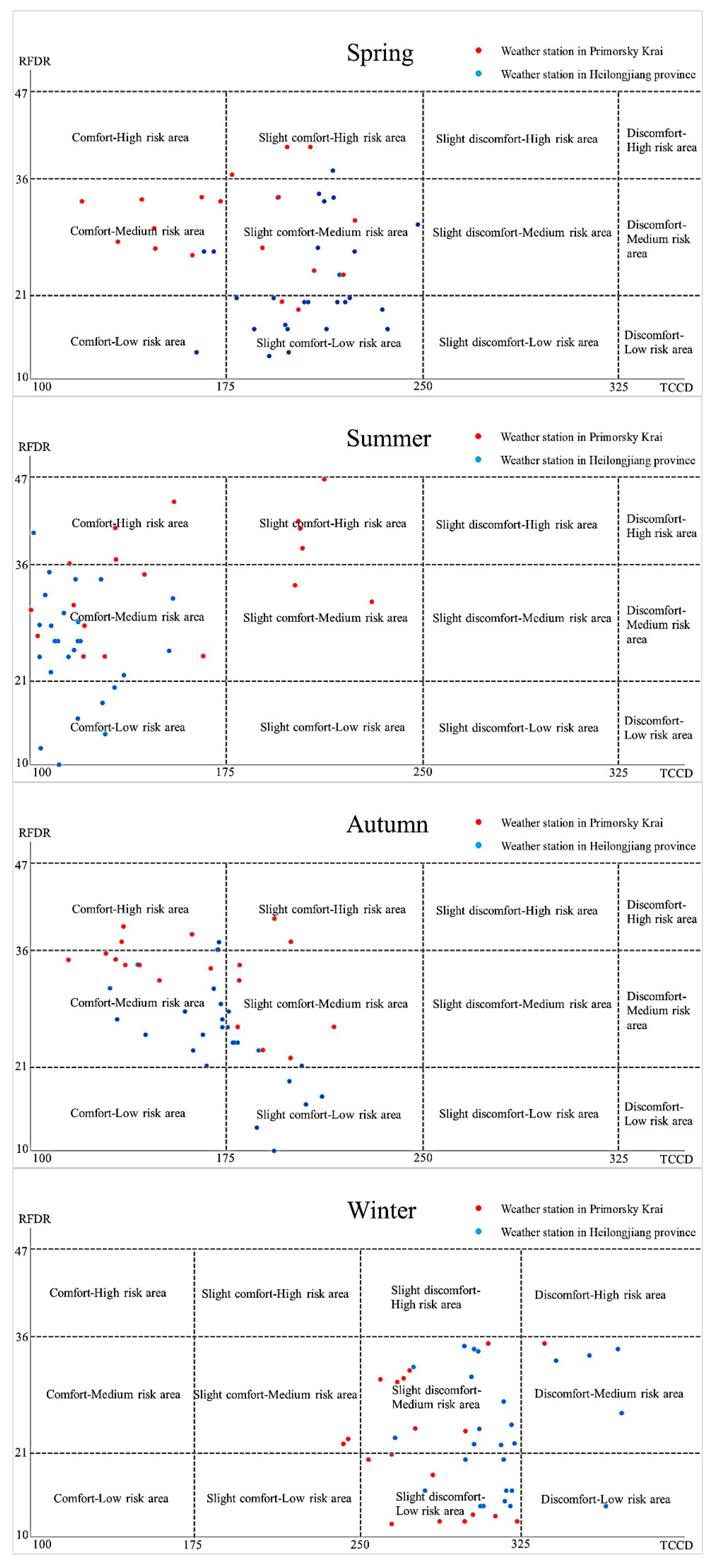Comprehensive Spatio-Temporal Analysis of Travel Climate Comfort Degree and Rainstorm-Flood Disaster Risk in the China–Russia Border Region
Abstract
:1. Introduction
2. Materials and Methods
2.1. Study Area
2.2. Data Sources
2.3. Methods
2.3.1. Evaluation Method for Travel Climate Comfort Degree (TCCD)
2.3.2. Evaluation Method of Rainstorm-Flood Disaster Risk (RFDR)
2.3.3. Combinatory Evaluation Method of the Travel Climatic Resources Based on the Coordinate System
3. Results
3.1. Spatial and Temporal Dynamic Evaluation of Travel Climate Comfort Degree
3.2. Spatial and Temporal Dynamic Evaluation of Rainstorm-Flood Disaster Risk
3.3. Comprehensive Evaluation of Travel Climate Comfort Degree and Rainstorm-Flood Disaster Risk
4. Discussion
5. Conclusions
Author Contributions
Funding
Conflicts of Interest
References
- Rosselló-Nadal, J. How to evaluate the effects of climate change on tourism. Tour. Manag. 2014, 42, 334–340. [Google Scholar] [CrossRef]
- Chow, C.K.W.; Tsui, W.H.K. Cross-border tourism: Case study of inbound Russian visitor arrivals to China. Int. J. Tour. Res. 2019, 21, 693–711. [Google Scholar] [CrossRef]
- Zhang, M. Analyses of and countermeasures on Heilongjiang province’s tourism cooperation with Russia in the background of the belt and road. SIB Stud. 2017, 44, 18–22. [Google Scholar]
- De Freitas, C.R. Tourism climatology: Evaluating environmental information for decision making and business planning in the recreation and tourism sector. Int. J. Biometeorol. 2003, 48, 45–54. [Google Scholar] [CrossRef] [PubMed]
- De Freitas, C.R.; Grigorieva, E.A. A comprehensive catalogue and classification of human thermal climate indices. Int. J. Biometeorol. 2015, 59, 109–120. [Google Scholar] [CrossRef] [PubMed]
- Terjung, W.H. Physiological climates of the conterminous United States: A bioclimatic classification based on man. Ann. Assoc. Am. Geogr. 1966, 56, 141–179. [Google Scholar] [CrossRef]
- Terjung, W.H. World patterns of the distribution of the monthly comfort index. Weather 1968, 12, 119–151. [Google Scholar] [CrossRef]
- Oliver, J.E. Climate and Man’s Environment: An Introduction to Applied Climatology; John Wiley&Sons Inc.: New York, NY, USA, 1978; pp. 195–222. ISBN 978-0-471-65338-7. [Google Scholar]
- David, D.H. Handbook of Applied Meteorology; John Wiley&Sons Inc.: New York, NY, USA, 1985; pp. 778–811. ISBN 978-0-471-08404-4. [Google Scholar]
- Li, Y.B.; Wang, X.M.; Li, C.C. Preliminary analysis of human comfort climate index in Heilongjiang Province. Heilongjiang Meteorol. 2009, 26, 22–24. [Google Scholar]
- Vitkina, T.; Veremchuk, L.; Mineeva, E.; Gvozdenko, T.A.; Antonyuk, M.V.; Novgorodtseva, T.P.; Grigorieva, E.A. The influence of weather and climate on patients with respiratory diseases in Vladivostok as a global health implication. J. Environ. Health Sci. Eng. 2019. [Google Scholar] [CrossRef]
- Veremchuk, L.V.; Mineeva, E.E.; Vitkina, T.I.; Grigorieva, E.A.; Gvozdenko, T.A.; Golokhvast, K.S. The response ranges of pulmonary function and the impact criteria of weather and industrial influence on patients with asthma living in Vladivostok. J. Environ. Health Sci. Eng. 2020. [Google Scholar] [CrossRef]
- Ma, L.J.; Sun, G.N.; Yang, R. A correlative analysis of the spatial and temporal relationship between climate comfort degree and tourist network attention for typical cities. Process Geogr. 2011, 30, 753–759. [Google Scholar]
- Zhang, T. Risk Zoning and Disaster Evaluation of Meteorological Disasters in Heilongjiang Province. Master’s Thesis, Huazhong University of Science and Technology, Wuhan, China, 2016. [Google Scholar]
- Aliperti, G.; Sandholz, S.; Hagenlocher, M.; Rizzi, F.; Frey, M.; Garschagen, M. Tourism, crisis, disaster: An interdisciplinary approach. Ann. Tour. Res. 2019, 79, 102808. [Google Scholar] [CrossRef]
- Rosello, J.; Becken, S.; Santana-Gallego, M. The effects of natural disasters on international tourism: A global analysis. Tour. Manag. 2020, 79, 104080. [Google Scholar] [CrossRef] [PubMed]
- Kottek, M.; Grieser, J.; Beck, C.; Rudolf, B.; Rubel, F. World map of the Köppen-Geiger climate classification updated. Meteorol. Z. 2006, 15, 259–263. [Google Scholar] [CrossRef]
- Cao, Y.N. Study on the Distribution Characteristics of Flood Disaster and Its Effect on Maize Yield in Heilongjiang Province. Master’s Thesis, Northeast Agricultural University, Harbin, China, 2017. [Google Scholar]
- Petrov, E.O.; Sokolikhina, N.N.; Semenov, E.K. Transformation of tropical cyclones on the polar front over the Primorsky Krai. Russ. Meteorol. Hydrol. 2019, 44, 564–570. [Google Scholar] [CrossRef]
- Sun, M.S.; Li, S. Empirical indices evaluating climate comfortableness: Review and prospect. Tour. Trib 2015, 30, 19–34. [Google Scholar]
- Zhou, Y.Z.; Wang, J.L.; Wang, Y.; Grigorieva, E.A. Estimation and evaluation of travel climate comfort degree in the cross-border region between China and Russia based on GIS. J. Res. Ecol. 2019, 10, 657–666. [Google Scholar] [CrossRef]
- Hu, Y.; Li, P.; Yang, J.G.; Zhu, Y. Applied Meteorology, 2nd ed.; China Meteorological Press: Beijing, China, 2015; pp. 194–195. ISBN 978–7-502–93098-1. [Google Scholar]
- Siple, P.A.; Passel, C.F. Measurements of dry atmospheric cooling in sub-freezing temperatures. Proc. Am. Philos. Soc. 1945, 89, 177–199. [Google Scholar] [CrossRef]
- Liu, H.Y.; Wu, Y.; Wang, N.A. Analysis of climate comfort conditions in the desert tourism zone in China. Resour. Sci. 2013, 35, 831–838. [Google Scholar]
- Qiu, C.; Cao, J.; Lin, L.C.; Liu, H.B.; Zhang, H.B. Estimation and evaluation of tourism climatic comfort levels in Shandong based on GIS. Resour. Sci. 2013, 35, 2501–2506. [Google Scholar]
- Zhang, X.M.; Yang, Q.J.; He, Z.M. Analysis and division of travel climate comfort level in Shandong. Sci. Surv. Mapp. 2014, 39, 140–147. [Google Scholar]
- Chen, X.; Pei, Z.; Wang, F. GIS-based assessment of rainstorm-induced geological hazards risk in Enshi autonomous prefecture. J. Geo Inf. Sci. 2016, 18, 343–352. [Google Scholar]
- Mo, J.F.; Lu, J.; Li, Y.L.; Kuang, Z.M. GIS-based assessment of agricultural flood and water-logging risk in Guangxi. J. Catastrophology 2012, 27, 38–43. [Google Scholar]
- Sui, G.; Hao, B.Y.; Peng, L. Data analysis of elevation standard deviation classifying relief degree of land surface. J. Taiyuan Univ. Technol. 2010, 41, 381–384. [Google Scholar]
- Pandey, A.C.; Singh, S.K.; Nathawat, M.S. Waterlogging and flood hazards vulnerability and risk assessment in indo Gangetic plain. Nat. Hazards 2010, 55, 273–289. [Google Scholar] [CrossRef]
- Huang, S.F.; Xu, M.; Chen, D.Q. GIS-based extraction of drainage network density and its application to flood hazard analysis. J. Nat. Disasters 2001, 4, 129–132. [Google Scholar]
- Yamazaki, D.; Ikeshima, D.; Sosa, J.; Bates, P.D.; Allen, G.H.; Pavelsky, T.M. MERIT hydro: A high-resolution global hydrography map based on latest topography datasets. Water Resour. Res. 2019. [Google Scholar] [CrossRef] [Green Version]
- Yu, Z.K.; Sun, G.N.; Feng, Q.; Luo, Z.W. Tourism climate comfort and risk for the Qinghai-Tibet Plateau. Resour. Sci. 2014, 36, 2327–2336. [Google Scholar]
- Simonenko, S.V.; Lobanov, V.B. The application of the generalized differential formulation of the first law of thermodynamics for evidence of the tidal mechanism of maintenance of the energy and viscous-thermal dissipative turbulent structure of the Mesoscale oceanic eddies. J. Mod. Phys. 2018, 9, 357–386. [Google Scholar] [CrossRef] [Green Version]
- Prushkovskaya, I.A. The impact of typhoons on the content of diatoms in sediments from Amur Bay (Sea of Japan) over the last 150 years. Bull. Kamchatka Reg. Assoc. Educ. Sci. Cent. Ser. Earth Sci. 2019, 42, 111–119. [Google Scholar] [CrossRef] [Green Version]
- Li, H. Risk Regionalization of Flood and Waterlogging in Weifang Based on GIS. Master’s Thesis, Nanjing University of Information Science & Technology, Nanjing, China, 2012. [Google Scholar]
- Okhotkina, V.E.; Vysotskaya, M.V. Assessment of ecological safety factors at the marine recreation organization in Primorsky krai. Int. J. Appl. Fundam. Res. 2015, 4, 85–89. [Google Scholar]




| THI (F) Range of Value | Somatosensory Classification | WCI (kcal/m2·h) Range of Value |
|---|---|---|
| <40 | Extremely cold | <−1000 |
| 40–45 | Chilly | −1000–−800 |
| 45–55 | Cold | −800–−600 |
| 55–60 | Cool | −600–−300 |
| 60–65 | Clear and Cool | −300–−200 |
| 65–70 | Warm | −200–−50 |
| 70–75 | Tending toward hot | −50–80 |
| 75–80 | Hot | 80–160 |
| >80 | Sultry | >160 |
| TCCDEM Range of Value | Classification Level | Assignment of Critical Value |
|---|---|---|
| <−272 | Discomfort (e) | 4 |
| −272–−208.5 | Slight discomfort (d) | 3.25 |
| −208.5–−145 | Slight comfort (c) | 2.5 |
| −145–−81.5 | Comfort (b) | 1.75 |
| −81.5–−48 | High comfort (A) | 1 |
| −48–−14.5 | Comfort (B) | 1.75 |
| −14.5–64 | Slight comfort (C) | 2.5 |
| 64–104 | Slight discomfort (D) | 3.25 |
| >104 | Discomfort (E) | 4 |
| Altitude (m) | Standard Deviation of Altitude | ||
|---|---|---|---|
| ≤1 | (1,10) | ≥10 | |
| [0,100) | 0.9 | 0.8 | 0.7 |
| [100,300) | 0.8 | 0.7 | 0.6 |
| [300,700) | 0.7 | 0.6 | 0.5 |
| ≥700 | 0.6 | 0.5 | 0.4 |
| Range of Travel Climate Comfort Degree Classification Threshold | Category | Range of Rainstorm-Flood Disaster Risk Classification Threshold | Category |
|---|---|---|---|
| 100–175 | Comfort | 10–21 | Low risk |
| 175–250 | Slight comfort | 21–36 | Medium risk |
| 250–325 | Slight discomfort | 36–47 | High risk |
| ≥325 | Discomfort |
© 2020 by the authors. Licensee MDPI, Basel, Switzerland. This article is an open access article distributed under the terms and conditions of the Creative Commons Attribution (CC BY) license (http://creativecommons.org/licenses/by/4.0/).
Share and Cite
Zhou, Y.; Wang, J.; Grigorieva, E.; Egidarev, E.; Zhang, W. Comprehensive Spatio-Temporal Analysis of Travel Climate Comfort Degree and Rainstorm-Flood Disaster Risk in the China–Russia Border Region. Sustainability 2020, 12, 3254. https://doi.org/10.3390/su12083254
Zhou Y, Wang J, Grigorieva E, Egidarev E, Zhang W. Comprehensive Spatio-Temporal Analysis of Travel Climate Comfort Degree and Rainstorm-Flood Disaster Risk in the China–Russia Border Region. Sustainability. 2020; 12(8):3254. https://doi.org/10.3390/su12083254
Chicago/Turabian StyleZhou, Yezhi, Juanle Wang, Elena Grigorieva, Eugene Egidarev, and Wenxuan Zhang. 2020. "Comprehensive Spatio-Temporal Analysis of Travel Climate Comfort Degree and Rainstorm-Flood Disaster Risk in the China–Russia Border Region" Sustainability 12, no. 8: 3254. https://doi.org/10.3390/su12083254







